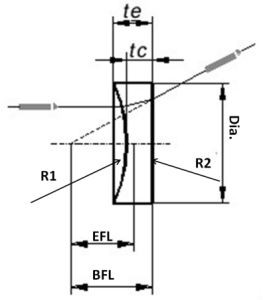Concave lenses have a wide range of applications in optical lenses. A concave lens, also known as a negative spherical lens, has a thin center and thick periphery, forming a concave shape, hence it is also called a concave lens. The following is a brief explanation of several characteristics of concave lenses.

A concave lens has a divergent effect on light. After a parallel light beam deflects through a concave spherical lens, it diverges and becomes a diverging light beam, making it impossible to form a real focal point. Along the opposite extension line of the diverging light beam, it intersects at point F on the same side as the projected light beam, forming a virtual focal point. The geometric construction of concave lens imaging is the same as that of convex lens imaging.
From the top of the object, it also serves as two straight lines: one parallel to the main optical axis, passing through a concave lens and deflecting into divergent light, returning this refracted light in the opposite direction to the main focus; Another optical center point passing through the lens, where these two lines intersect at a point, is the image of the object. The image formed by a concave lens is always smaller than the upright virtual image of the object, and concave lenses are mainly used for correcting myopia. Concave lenses can also be divided into: double concave lenses, which are lenses with two concave sides; A flat concave lens is a lens with one concave side and one flat side; Convex concave lens refers to a lens with one side convex and one side concave.
The line connecting the curvature centers on both sides of a concave lens is usually referred to as the main axis, and the central point O is called the optical center. The light passing through the optical center does not refract no matter where it comes from. A beam of light parallel to the main axis, when refracted on a concave lens, diverges in all directions. The extension line that opposes its divergence direction will all converge at one point F on the same side as the light source, and the refracted light is exactly emitted from point F, which is called the virtual focal point. There is one on each side of the lens.
A concave lens is also known as a divergent lens. The focal length of a concave lens refers to the distance from the focal point to the center of the lens. The larger the spherical curvature radius of a lens, the longer its focal length. If it is a thin lens, the focal lengths on both sides are equal.



